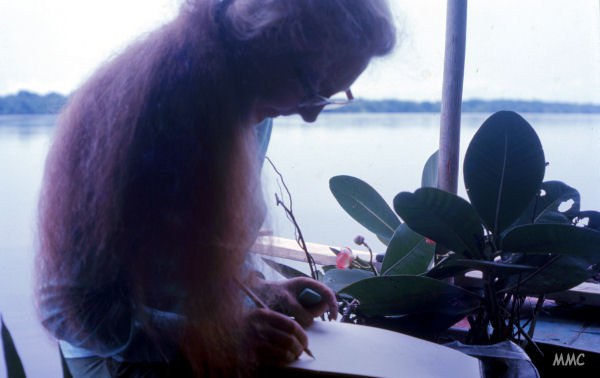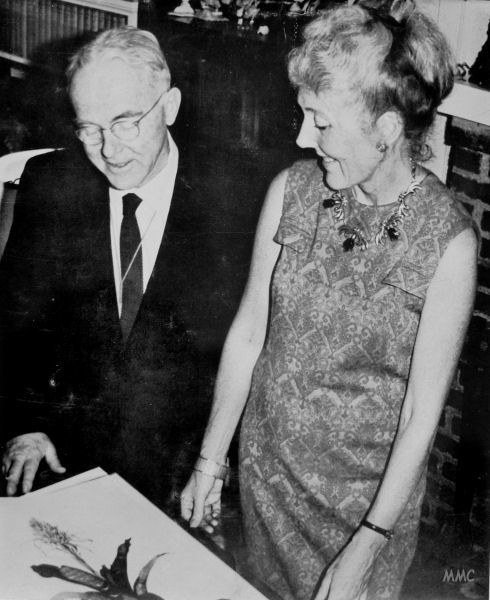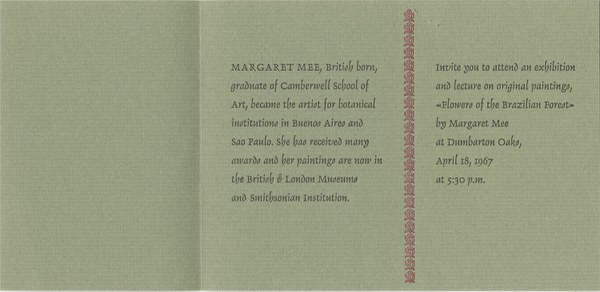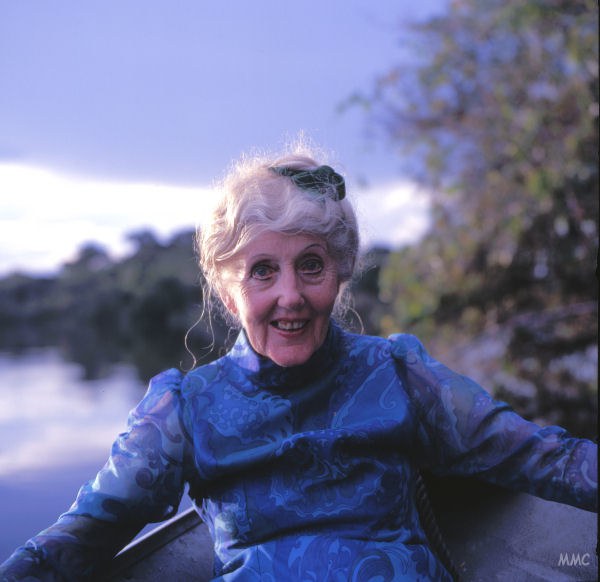Margaret Ursula Mee was born in May 1909 near Chesham, thirty miles outside of London. However, she made a name for herself half a world away in the Brazilian Amazon. Mee and her future husband Greville—a successful commercial artist—first traveled to São Paulo in 1951 to care for Mee’s ailing sister. “We thought we would stay for three or four years,” Greville later remarked, “but it has grown into a lifetime” (Morrison, ed., Margaret Mee, in Search of Flowers of the Amazon Forests, 24).
Mee began work as a teacher at a local art school, and soon she became inspired by the region’s flora, particularly the coastal forests. In 1955, she decided to travel deep into the Amazon, then a twelve-hour flight away, on her first expedition. The following January, Mee set off for the region of the Gurupí, a tributary of the Amazon River.
The expedition lasted for months. During this time, Mee lived among the indigenous people and endured multiple hardships, from malaria and hepatitis to scores of insects, giant anacondas, and nightly attacks by vampire bats. Rather than being deterred by the untamed tropics, Mee was invigorated and inspired. Coming back from this first expedition, she said, “Now Amazonia was in my blood” (Morrison, ed., Margaret Mee, in Search of Flowers of the Amazon Forests, 43).
![Mee at Xavantina, 1964 Margaret with Xavante [Indians] at Xavantina, Mato Grosso, 1964.](https://www.doaks.org/resources/online-exhibits/margaret-mee-portraits-of-plants/exhibition-images/mmxr0020s2-do.jpg/@@images/d32aa787-9d8b-438e-b2c4-9c28152ba1a8.jpeg)
Mee at Xavantina, Mato Grosso, 1964. Photograph: South American Pictures, Tony Morrison

Mee sketching a Clusia, Rio Negro, 1967. Photograph: South American Pictures, Tony Morrison
The trip proved artistically fruitful for her. Mee returned to São Paulo with a portfolio filled with sketches, dramatic landscapes, and meticulous botanical studies. She presented her work to the city’s Botanical Institute. Impressed, the botanists sponsored an exhibition of her paintings. Mee continued showing her work throughout 1958. An exhibition in Rio de Janeiro brought her to the attention of many well-known professionals such as landscape architect Roberto Burle Marx, Dr. Alcides Teixeira, the Director of the Botanical Institute of São Paulo, and Dr. Lyman Smith of the Smithsonian.
Smith, a world authority on bromeliads, invited Mee to join him on a project cataloging tropical flowers for his Flora Brasilia series. Working side by side with a botanical authority like Smith, Mee rapidly acquired a specialist’s knowledge of bromeliads and a particular brilliance in depicting them. On later expeditions into the Amazon, using her then-experienced field botanist’s eye, she discovered three new species which were named after her: Aechmea meeana, Neoregelia margaretae, and Neoregelia meeana.
Smith and Mee published their collaborative volume, The Bromeliads, in 1969. In the introduction, Smith wrote “As you look at these pictures, remember that they achieved their artistic effect and scientific accuracy because Margaret Mee was not satisfied to drag a dying plant back to the comfort of her studio nor to reconstruct from a dead one. Instead, she met them where they lived and painted them there, evolving a highly successful technique through trial and error” (Smith and Mee, The Bromeliads, 5).

Mee and Lyman Smith, 1960s. The painting in the photograph is unidentified, but it may be Aechmea caudata or organensis. Photograph: South American Pictures, Tony Morrison

Mee began her relationship with Dumbarton Oaks around this time. After her third expedition (1964), Mee left the São Paulo Botanical Institute and transitioned to painting full-time. The evening lecture she gave at Dumbarton Oaks in April of 1967 helped introduce her work to a much larger audience, including Dr. Leonard Carmichael of the National Geographic Society. This encounter led to the Society sponsoring Mee’s next expedition, this time to a little-known Amazonian mountain, the Serra da Neblina—the “Mountain of Mist.”
In total, Mee made fifteen journeys to remote areas of the Amazon; some were scientifically groundbreaking, others an artist traveling for subjects. She received a Guggenheim Fellowship, and the Brazilian government funded a folio of paintings. Shows of her work continued, culminating in a watershed exhibition at Kew Gardens in 1988–89. The Kew Gardens exhibition coincided with the publication of her book, In Search of Flowers of the Amazon Forests, based on excerpts from her travel diaries covering expeditions between 1956 and 1988. The later diaries documented the destruction of massive parts of the forests. Mee became a significant spokesperson for conservation of the Amazon, helping to document the devastation through her work. During the thirty years of her career, she saw Amazonia shrink from a vast wilderness to an endangered ecosystem encroached by civilization and commercial exploitation.
While in England in 1988 for interviews and lectures to raise awareness for the Amazon and support the Kew exhibition, Mee was killed in a car accident. Her activism may have ended, but her work lives on. A unique combination of scientific accuracy and artistic beauty characterizes her paintings, and Mee is considered by her peers to be among the best in the field of botanical illustration. Parts of the Amazon she so loved are now gone, and many of the plants she carefully rendered are extinct, but her paintings remain a testament to the endangered beauty of the rainforest.

Riverside celebration during Mee’s final journey, May 1988. In this photograph, Mee was dressed for a riverside celebration of her 15th expedition. She specifically wore the blue dress because she had both designed and made it. Mee handmade all her clothes. Some she designed and some were designed for her by her close friend Roberto Burle Marx. Photograph: South American Pictures, Tony Morrison
Additional Resources
Exhibit Items
Photograph: Otis Imboden/National Geographic Creative
Photograph: Otis Imboden/National Geographic Creative
Photograph: South American Pictures, Tony Morrison
Photograph: South American Pictures, Tony Morrison
Photograph: South American Pictures, Tony Morrison
Photograph: South American Pictures, Tony Morrison
Photograph: South American Pictures, Tony Morrison






